A U.S.-Mexico Border Wall Could Be Bad News for Wildlife

In late January, the Trump administration announced plans to move forward on building a border wall along the southern border with Mexico. A cornerstone of the Trump campaign, the wall not only presents human, financial, and international relations concerns, but would also have dramatic consequences for wildlife.
The U.S.-Mexico border region is a rich ecosystem, home to a diverse array of plant and animal life. According to a 2016 report by Outside magazine conducted using the U.S. Fish and Wildlife Service’s iPac tool, a wall running across the entire 2,000-mile border between the two countries would potentially affect more than 100 endangered species, 108 migratory bird species, four national wildlife refuges, and an unknown number of protected wetlands. Critical wildlife corridors on these lands link habitat on both sides of the border, allowing species to move around freely to find necessary resources like food and mates.
Currently, about 40% of the border (nearly 700 miles) is lined with physical barriers, including walls, fences, and low-height vehicle barriers. Much of this disjointed but significant series of barriers was constructed following the 2005 REAL ID Act. Under the Bush Administration, the Department of Homeland Security waived more than 30 environmental and cultural laws, including the Endangered Species Act, to expedite an extension of the border fence in the name of national security.
The existing barriers are already having a detrimental effect on wildlife. A 2011 study showed that the new fence and proposed fences along the border could threaten endangered species and animals with small habitats, such as the California red-legged frog and the jaguarondi, a small wild cat.

Barriers such as the border wall can create small, isolated populations. Isolated populations lose genetic variation over time. This isn’t a problem in open populations, because migrants bring in new genetic variation that replenishes random loss. Man-made barriers prevent the influx of new genetic material into a population, resulting in increased vulnerability to inbreeding and disease.
Walled-Off Wildlife
An impregnable wall along the entire U.S.-Mexico border could mean the end of jaguars in the U.S. and the decline of gray wolves, ocelots and other animals in southern regions.
Jaguars once traversed a connected landscape from the southern U.S. to Argentina. Today, their range has shrunk by over 40% and the big cats no longer have resident breeding populations in the U.S. All jaguars identified in the U.S. in recent years are believed to have traveled north from Mexico, which has critical jaguar habitat only 100 miles from the border. The wall would prevent the migration of jaguars within wildlife corridors between Mexico and the U.S., dashing hopes for a natural re-colonization of the U.S.
Another endangered apex predator, the Mexican gray wolf, would also be impacted by the construction of a border wall. As of 2016, there were 113 of these wolves in the U.S. and about three dozen south of the border. The wall would separate these populations and threaten the recovery of the species.

Other research has concluded that border barriers disrupt the movements and distribution of the low-flying ferruginous pygmy owl and isolated populations of mammals such as bighorn sheep, black bears, and pumas. These species exist in small, fragmented groups, so their ability to move between populations is important to their continued survival.
And it’s not just the physical barriers that affect wildlife. Construction of a wall would mean a significant increase in human activity: more roads, heavy machinery, border agent patrols, and removal of vegetation may all disrupt movement or other animal behavior.
Wild animals do not care about our human concept of borders; ecosystems do not stop at walls and fences. Artificial divides have the potential to break up the landscape and negatively impact wildlife, especially endangered species and small populations. While the human consequences of a border wall have received the most attention, the adverse effects on wildlife and the environment are substantial and should not be overlooked.
